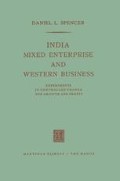Abstract
The previous chapter has identified the type of mixed corporation with which this study is primarily concerned as public and private participation in the equity capital of corporations with some share in the direction of the destinies of the enterprise. A comparative survey of mixed enterprise throughout the world revealed that there was a marked tendency to treat the phenomenon as merely a variant of public enterprise. This tendency was especially marked in the Anglo-Saxon countries where the tradition of the non-economic, guardian state was strong. India stood as an interesting approach to the mixed enterprise because the framework of its industrial policy called for an equality and mutuality of economic effort as between the public and private sectors. In short, the Indian dualistic approach is, at least on the theoretical level, an attempt to make the mixture more a partnership of equals. The present study takes India’s fundamental conception as a point of departure and seeks to explore the advantages and disadvantages to the participants. Assuming a mixed corporation in which public and private enterprise is participating on terms approaching a relationship of equals, what a priori conclusions can be drawn?1 This chapter offers a first approach by utilizing formal economic theory.
Access this chapter
Tax calculation will be finalised at checkout
Purchases are for personal use only
Preview
Unable to display preview. Download preview PDF.
References
Modern corporations are very intricate mechanisms providing many-sided functions in modern economic life; see Peter Drucker, The Concept of the Corporation (N.Y., 1946).
A. A. Berle and C. C. Means, The Modem Corporation and Private Property (N.Y., 1932).
In India, Mysore Sugar, a mixed enterprise, operated in an industry of over yo producers, see chapter 6.
See J. M. Keynes, The General Theory of Employment, Interest and Money (N. Y., 1935), pp. 372–5, ff. passim.
Keynes suggested “all manner of compromises and of devices by which public authority will co-operate with private initiative” as one significant way to reduce income inequalities. Keynes, op. cit., p. 378.
P. M. Sweezy, “Demand Under Conditions of Oligopoly,” Journal of Political Economy, 47 (Aug., 1939), 568–73.
Author information
Authors and Affiliations
Rights and permissions
Copyright information
© 1959 Martinus Nijhoff, The Hague, Netherlands
About this chapter
Cite this chapter
Spencer, D.L. (1959). Some Notes for a Theory of Mixed Enterprise. In: India, Mixed Enterprise and Western Business. Springer, Dordrecht. https://doi.org/10.1007/978-94-015-0713-4_5
Download citation
DOI: https://doi.org/10.1007/978-94-015-0713-4_5
Publisher Name: Springer, Dordrecht
Print ISBN: 978-94-015-0212-2
Online ISBN: 978-94-015-0713-4
eBook Packages: Springer Book Archive

